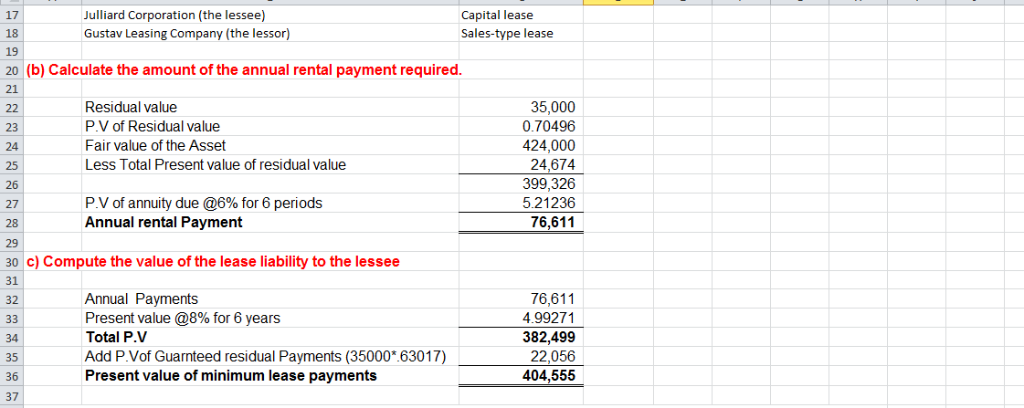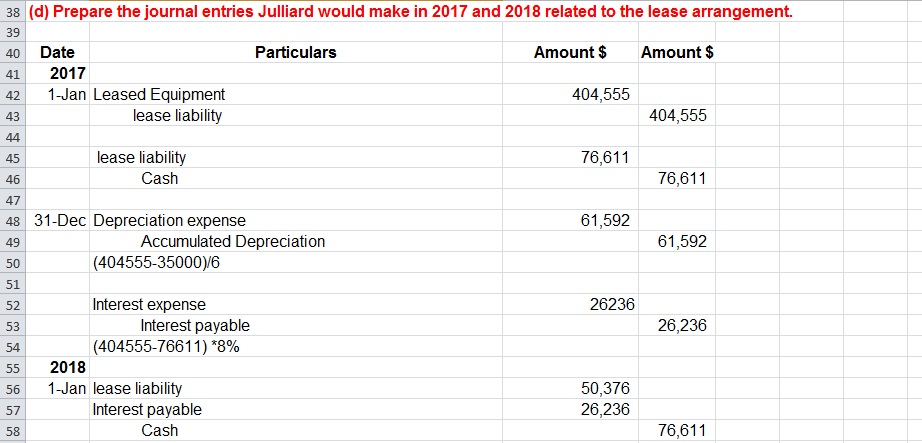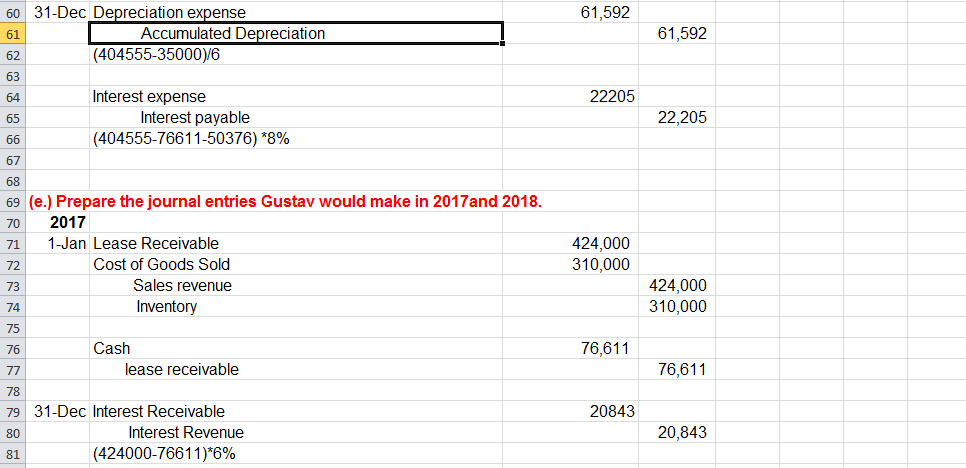Question
In: Accounting
Gustav Leasing Company agrees to lease equipment to Julliard Corporation on January 1, 2017. The following...
Gustav Leasing Company agrees to lease equipment to Julliard Corporation on January 1, 2017. The
following information relates to the lease agreement.
1. The term of the lease is 6 years with no renewal option, and the machinery has an estimated
economic life of 8 years.
2. The cost of the machinery is $310,000, and the fair value of the asset on January 1, 2017, is $424,000.
3. At the end of the lease term, the asset reverts to the lessor and has a guaranteed residual value of
$35,000. Julliard estimates that the expected residual value at the end of the lease term will be $35,000.
Julliard amortizes all of its leased equipment on a straight-line basis.
4. The lease agreement requires equal annual rental payments, beginning on January 1, 2017.
5. The collectability of the lease payments is probable.
6. Gustav desires a 6% rate of return on its investments. Julliard’s incremental borrowing rate is 8%, and
the lessor’s implicit rate is unknown.
(Assume the accounting period ends on December 31)
(a) Discuss the nature of this lease for both the lessee and the lessor.
(b) Calculate the amount of the annual rental payment required.
(c) Compute the value of the lease liability to the lessee.
(d) Prepare the journal entries Julliard would make in 2017 and 2018 related to the lease arrangement.
(e) Prepare the journal entries Gustav would make in 2017 and 2018 related to the lease arrangement.
(f) Suppose Julliard expects the residual value at the end of the lease term to be $28,000 but still
guarantees a residual of $35,000. Compute the value of the lease liability at lease commencement.
(g) Suppose the residual value is unguaranteed, how would Gustav’s journal entries change?
Solutions
Related Solutions
Glaus Leasing Company agrees to lease equipment to Jensen Corporation on January 1, 2017. The following...
Riverbed Leasing Company agrees to lease equipment to Marin Corporation on January 1, 2017. The following...
Sheffield Leasing Company agrees to lease machinery to Tamarisk Corporation on January 1, 2017. The following...
Glaus Leasing Company agrees to lease machinery to Jensen Corporation on January 1, 2017. The following...
Monty Leasing Company agrees to lease machinery to Flounder Corporation on January 1, 2017. The following...
Kingbird Leasing Company agrees to lease machinery to Oriole Corporation on January 1, 2017. The following...
Vaughn Leasing Company agrees to lease machinery to Bramble Corporation on January 1, 2017. The following...
Blue Leasing Company agrees to lease equipment to Kingbird Corporation on January 1, 2020. The following...
Grouper Leasing Company agrees to lease equipment to Monty Corporation on January 1, 2020. The following...
Gerbil Leasing Company agrees to lease equipment to Playa Corporation on January 1, 2014. The following...
- National Co. manufactures and sells three products: red, white, and blue. Their unit sales prices...
- PRINCIPLE # 4: FALLING UP PRINCIPLE # 5: THE ZORRO CIRCLE PRINCIPLE # 6: THE 20-SECOND...
- Explain digestion from the mouth to the anus. What are the enzymes that carrying it ?...
- Im trying to derive Cp - Cv = R where Cp and Cv are the molar...
- Ernest Rutherford (the first New Zealander to be awarded the Nobel Prize in Chemistry) demonstrated that...
- What is an example in society about Hypothesis testing?
- Use tabulated half-cell potentials to calculate ?G?rxn for each of the following reactions at 25 ?C....




 ekkarill92 answered 2 months ago
ekkarill92 answered 2 months ago